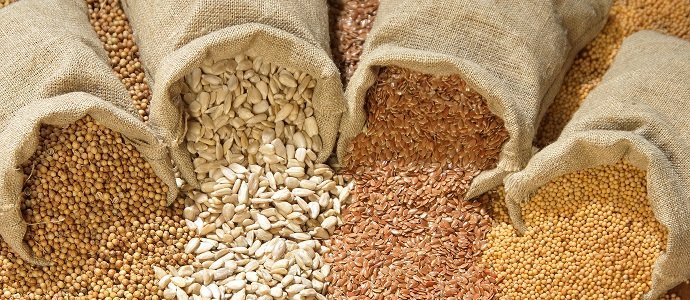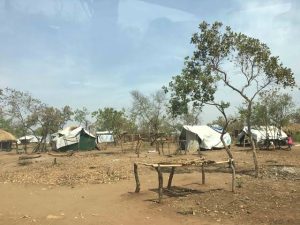Establish more seed banks to preserve endangered crop varieties and rare plant species – Emmanuel Mwesige
7 min read
Establish more seed banks to preserve endangered crop varieties and rare plant species – Emmanuel Mwesige
Climate change and variability aggravate the challenges associated with agricultural livelihoods, with farmers struggling to maintain crop diversity, now more than ever. Existing mechanisms to meet farmers’ seed requirements are inadequate, but there is hope. Studies indicate that seed banks can improve farmer resilience through improved access to diverse, locally adapted crops and varieties, and enhance indigenous knowledge and skills in plant management, including seed selection, treatment, storage, multiplication and distribution.
Seed banks also act as repositories of local genetic diversity that is often adapted to prevailing climate conditions, including biotic stresses, such as crop pests. They can also be part of community-based adaptation strategies to climate change.
Various initiatives across Uganda should demonstrate that seed banks are climate-smart and have potential to enhance crop productivity, income and household food security in the context of a changing climate.
Before getting into how seed banks can help impoverished areas, their definition needs to be established. A seed bank is a place where seeds of different crops and rare plant species are stored to preserve genetic diversity for future use. They are usually flood, bomb and radiation-proof vaults holding jars of seeds from different plant species. The seeds are stored in air-tight glass containers stacked in huge -20°C freezers underground and can be used to grow a new generation of plants in years to come.

Seed banks are created to maintain and protect biodiversity, where samples of all species are collected and stored. In case seed reserves elsewhere are destroyed, the seed bank is opened to provide seeds to farmers at defined quantities for growing plants. Presently, more than 1,000 seed banks exist around the world, varying in type, size and focus. Of all the existing seed banks in the world, the largest is the Millennium Seed Bank in Sussex, managed and coordinated by the Royal Botanic Gardens, Kew. It opened in 2000 and holds seeds from almost 40,000 species around the world, including nearly all the UK’s native trees and plants.
It is worth noting that everybody can create his/her own seed bank. It is as simple as taking the seeds from the produce and freezing them in a little container for later use. People can also take seeds and donate them to help fight world hunger and feed families across the globe. Organizations like Seeds to the World (StW), Seeds of Peace (SoP) and Seed Global Health (SGH), among others, all accept donations of seeds from the produce people eat every day as well as prepackaged seeds.
With the rise of genetically modified plants and climate changes people all across the globe face issues related to agriculture and food production. Seed banks can aid areas that are most affected by hunger by ensuring the conservation of local crops that are already adapted to the region and reviving the use of specific plants to provide agricultural stability.
Globally, it is estimated that 40% of plant species are vulnerable to extinction. A seed bank is a form of insurance policy for plants and trees, a way of maximizing the number of plant species we can save from this fate.
Based on the above statistics, seed banks are more essential now than ever before. Plants are under threat from many factors, including; habitat loss, climate change, pollution, pests and diseases among others. The rate of their impact is also increasing, leading to an ever-greater risk of an incremental and catastrophic loss. We are potentially losing plants faster than we are discovering them.
Seed banks primarily involve in selecting, collecting, and storing seed varieties. They also form seed exchange networks with government organizations, non-governmental organizations (NGOs) and community seed banks across the world. They also form ex situ (‘off site,’ ‘out of place’) storage facilities. They help in seed exchange, on farm conversation with experts and farmers, training and capacity building for farmers and continuous monitoring of cultivation. For that matter, experts and volunteers all over the world are out in the field carefully collecting seeds for the banks. Rigorous criteria make sure the best seeds are collected and stored. It’s common practice for each bank to send out a proportion of its valuable seeds to another bank as additional insurance.
In order to ensure successful seed banking, experts advise on the following steps:
First, researchers decide what seeds to collect. Generally, they give priority to threatened plants.
Secondly, after plants are located, seed collection begins. Seeds are most viable for collection and storage when ripe. In the case of fruits, most release their seeds when ripe. However, some plants will retain their seeds for extended periods, which allows a longer collection time. Other plants might seed irregularly, and thus require repeat visits.
Thirdly, researchers collect the seeds manually with tweezers, pole cutters, seed traps or nets and buckets, depending on the type of plant. For each collection, they record details like location, plant description, habitat, soil type and other information. This information provides data about the local plant population and ensures optimal replanting conditions.
Next, collectors then assign each sample a unique number. Collectors then clean each sample to ensure high quality. Seeds can be cleaned by shaking them through a sieve or with a machine that blows air on them.
To reduce the moisture content of the seeds, collectors dry them in a temperature- and humidity-controlled room. Afterwards, they place the seeds in sealed-airtight containers.
The final storage step is to freeze the seeds at minus 4 degrees Fahrenheit (minus 20 degrees Celsius).
In theory, seeds stored in these vaults can remain dormant for hundreds or even thousands of years, depending on the species. Nothing like this has been attempted before though, so these predictions can only be based on models. There are a few reports and examples of ancient seeds found in pyramids and ancient palaces that have germinated, but data on seed longevity is scarce. Until the first stored seeds reach 1,000 years old, we only have models to rely on. The best prediction suggests that at the very least, seeds will survive for 150 years in vaults-but hopefully much longer.
It is imperative to note that seeds stored at the seed bank may be owned by the collectors or the curators, and the owner will have the final say on the use of the seeds.
Some banks only store seeds related to agricultural crops as insurance against genetic loss in our food varieties. Others only hold seeds from rare species and may be very selective on how these seeds are used. Or they might hold many seeds for various purposes, from restocking populations to research projects and plant breeding programmes. A good example is the clover glycine (Glycine latrobeana), a rare herb native to Australia. In 2007, around 1,200 seeds were sent to the UK for storage at the Millenium Seed Bank. When bushfires destroyed a major habitat for the small plant in early 2020, the seed bank was able to send 250 seeds back to Australia to help them reestablish in the wild again.
By strengthening seed banks, numerous positive outcomes can be enjoyed by farmers located in the area where the seed bank is situated. Some of these include:
Preservation of crop diversity. This is the most important reason for the storage of seeds. Just as human beings and animals are adapted to different conditions for survival, so are crops. Different types of the same species exist due to this adaptive nature. Therefore, it is of critical necessity that such diversity is preserved.
Protection from climate change. For a couple of decades now, the world has witnessed radical climatic change that has been accelerated by increased industrial pollution. Crop extinction is inevitable with such extreme changes. If seeds are stored in seed banks, the danger of total elimination of certain species of crops is eliminated.
Protection from natural disasters. Natural disasters are unforeseen events that could lead to complete annihilation of crops from the face of the earth. The foresight of keeping seeds in a seed bank could save such a situation. Malaysian rice paddies, for example, were wiped out during the 2004 tsunami and international seed banks provided farmers with seeds that helped them start over.
Disease resistance. Crop diseases are highly contagious and very deadly to plants. A serious breakout could completely eliminate crops. Where diseases have ravaged crops and left no traces that farmers could start on, seed banks can intervene and provide them with seeds that will enable them start on a clean slate.
Provide seed material for research: Seeds that are stored in seed banks can be made easily available to scientists and researchers who wish to study these seeds especially if such research could lead to improvement of crop production.
Preservation from man-made disasters. Man-made disasters such as war and oil spills could lead to the annihilation of crops. Counties that are engaged in war make it difficult for farmers to continue farming and it’s easy for crops to disappear. Once peace is restored, seeds can be retrieved from seed banks and replanted.
In conclusion, therefore, it ought to be noted that, properly stored seeds can stay viable for even millennia, eliminating the risk of losing crops that are critical for the existence of human beings, animals, and birds. Thus, against this above background, I strongly recommend to government specifically the Ministry of Agriculture Animal Industry and Fisheries (MAAIF), to strengthen seed banks, as this is the only way through which as a country, we can be in position to preserve endangered crop varieties and rare plant species.
Emmanuel Mwesige-Agriculturalist, accounting specialist, researcher and author.
Tel: +256704004263/0778954346: Email: emmanuelmwesige2021@gmail.com or emmanuel.mwesige@gmail.com





